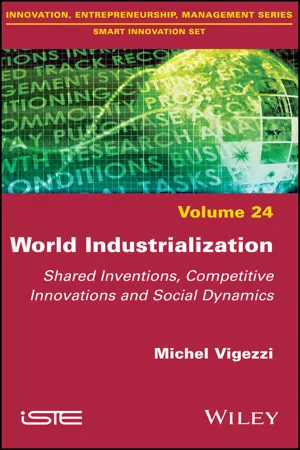
World Industrialization
Shared Inventions, Competitive Innovations, and Social Dynamics
- English
- ePUB (mobile friendly)
- Available on iOS & Android
World Industrialization
Shared Inventions, Competitive Innovations, and Social Dynamics
About This Book
Based on the paradigms of economics and management, inspired by the history of technology and the sociology of technological change, the concepts of shared inventions and competitive innovations make it possible to analyze the industrialization of the world in a fresh and efficient way. As a new approach, shared inventions are classified in this book as a set of existing knowledge thats often associated with the rediscovery of old techniques. Determining capitalized and collective intelligence, this knowledge and reinvention allows us to create inventions which will be shared, first in their construction, then in their use. Another new approach is that these competitive innovations are defined in World Industrialization by associations of experiences of competitively-motivated actors – actors seeking to complement existing techniques by increasing their competitive power. These shared inventions and competitive innovations will also be defined by trajectories identifying their modes of creation, enabling us to overcome the peculiarities of these actions and competitions. This book also highlights four key areas in global industrialization: the emergence of machinism with the defense of Arts and Crafts from 1698–1760; the changes the Industrial Revolution wrought in developed nations from 1760–1850; the link between technology and social relations within modern companies from 1850–1914; and, from 1914 onwards, the birth of extended machinism, its world wars and its global crises.
Frequently asked questions
Information
PART 1
Industrialization and its Conceptualizations
Introduction to Part 1
1
The Notion of Industrialization and Other Related Notions
1.1. The notion of industrialization
1.1.1. The birth of the notion of industrialization
1.1.1.1. Initial representations of the notion of industrialization
- – The first set is based on tautological definitions of industrialization considered as a process of extension and intensification of industrial activities, or as the act of making a process or technique industrial.
- – The second set uses a definition based on the fact that industrial production exceeds agricultural production in terms of volume.
- – The third and most common set relies on external and/or pointillist definitions, such as: manufacturing processes that use techniques to allow high labor productivity; a group of workers in unchanging infrastructure with fixed schedules and strict regulation; a process that reverses production techniques, replacing the artisanal system with a production that resorts more and more to energy that comes from machines; centralized mass production that uses norms or standards in order to obtain products of homogeneous quality; or a shift from domestic work to more and more specialized work, which radically changes lifestyles.
- – The fourth set opts for vagueness or detachment by affirming that industrialization is the modernization of contemporary societies born from an evolution of the industrial process, relying on mechanization and automation; it also affirms that the industrial revolution would involve the formation of a new mode of production and the setting up of a scientific organization of work: the assembly line.
1.1.1.2. Criterial definitions of the notion of industrialization
1.1.2. Industrialization according to economists
1.1.2.1. Classical economists and industrialization
Table of contents
- Cover
- Table of Contents
- Acknowledgments
- Introduction
- PART 1: Industrialization and its Conceptualizations
- PART 2: Historical Periods, Social Dynamics, Shared Inventions and Competitive Innovations
- Conclusion: Cycles and Networks
- References
- Index
- End User License Agreement